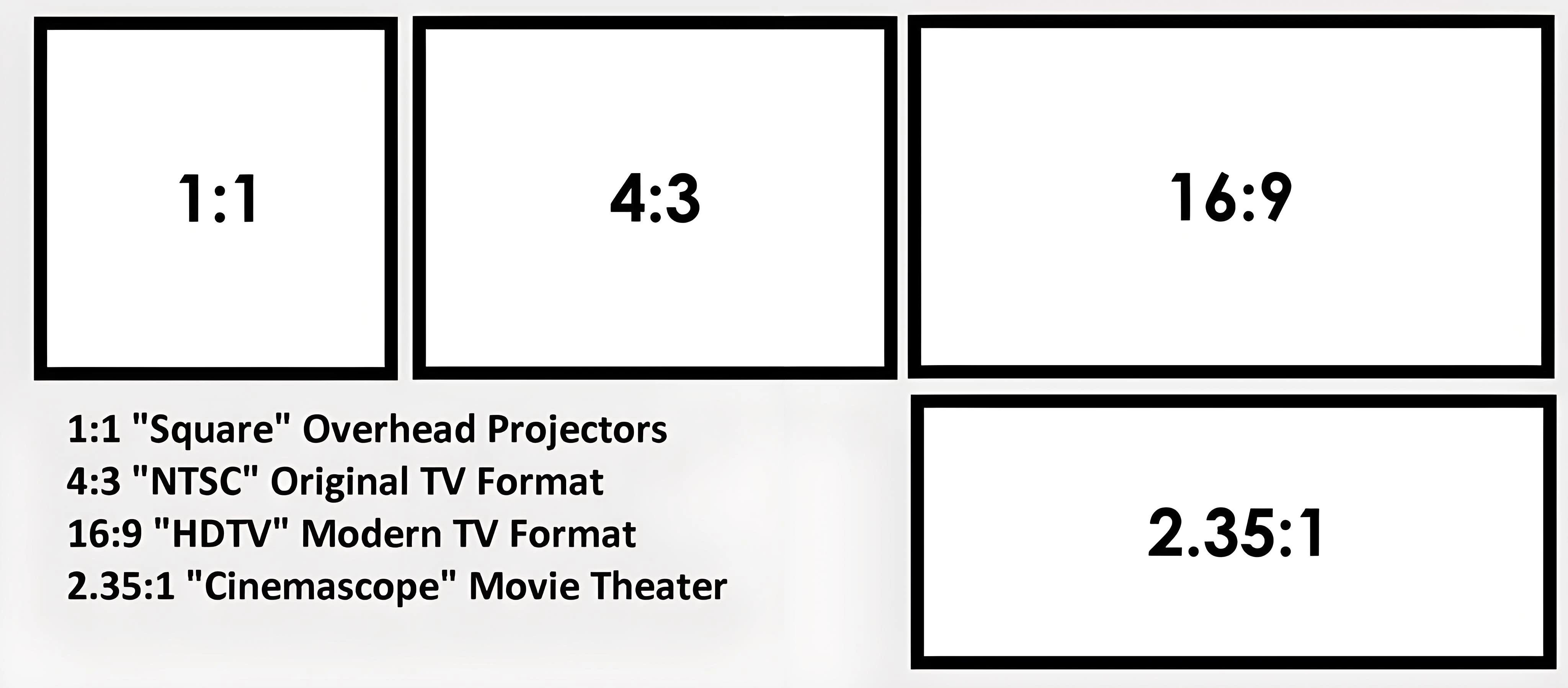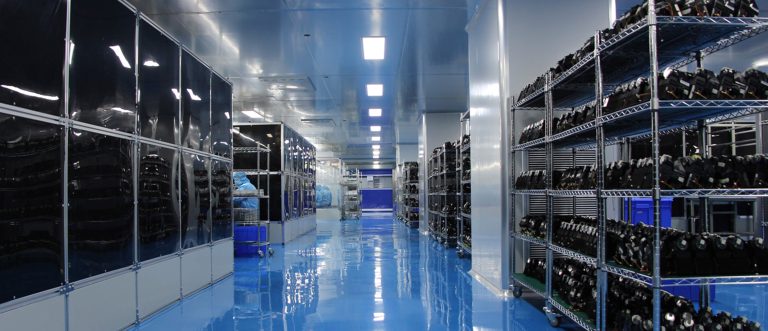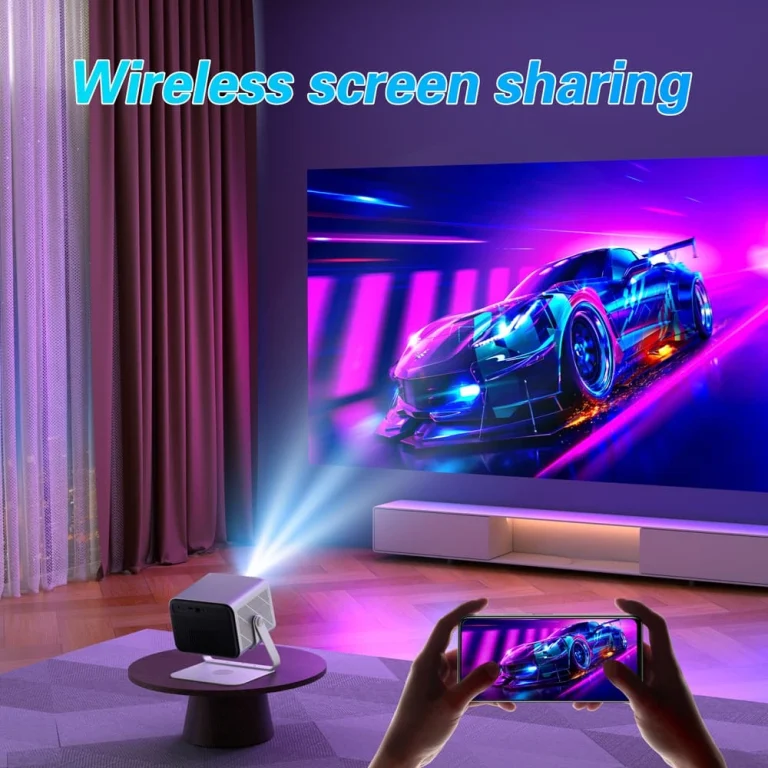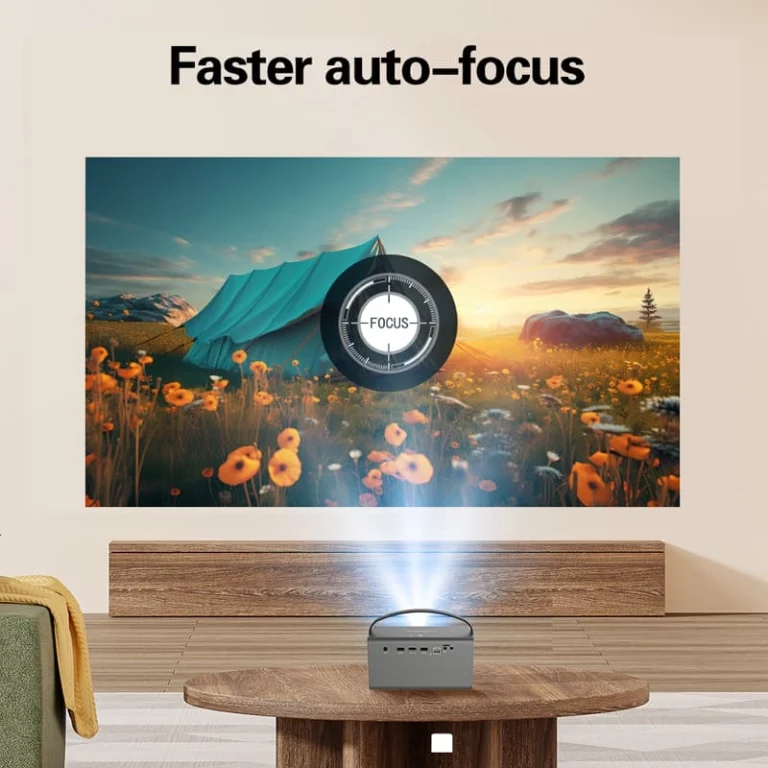As you delve into the home theater experience, the outstanding color and contrast performance of a DLP Projector is likely the reason this type of projector is now your first choice. However, you are probably often asked the question: “Do I really need a dedicated screen for my DLP projector or can I just project on a plain, white wall?”
A simple “yes” or “no” will not do. It is fine to project on a white wall, however, with the right dedicated screen, you will absolutely have the best experience. To put it another way, it’s the difference between someone fueling up a high-performance sports car with standard grade fuel versus premium fuels. The car will run with standard fuel, but it needs the premium fuel in order to access the high-performance.
This article will explore in-depth the question of how to choose a projector screen. The positives and negatives will be examined, and a complete purchasing and usage guide will be provided to give you the best chance of making a well-informed consumer decision.

Screen vs. Wall: Is a Projector Screen Truly Necessary?
For those new to projectors, a smooth white wall may seem like a logical surface. However, a fundamental difference in optical properties exists between a wall and a professional screen, which leads to a significant gap in the final image quality.
The Limitations of a White Wall: Why It Is Not Recommended by Professionals
Though convenient and cost-free, using a white wall as a projection surface presents several core issues:
- Poor Reflective Properties: A white wall is just a diffuse surface and it’s Gain is likely 1.0, meaning light isn’t efficiently bundled and reflected toward your eyes like it would be on a professional screen. This will result in a loss of brightness and contrast, particularly in ambient light situations.
- Poor Color Reproduction: The paint on your wall is not optically pure white and will likely yellow or discolor over time. Therefore, this will directly affect your projected image color accuracy and will lead to a color cast.
- Lack of Sharpness due to Surface Texture: In a wall that may look smooth, there are still microscopic textures and other concerns. Such textures disrupt the crisp presentation of pixels, thus reducing sharpness and ruining the ultimately impressive look of HD or 4K sources.
- No Black Border: Typically a proper screen has a black border. Not only does bullet the image, but it also boosts perceived contrast so your attention can remain solely on the content – this is a process referred to as “visual anchoring.”
There are conditions (like using a very bright projector (over 2000 ANSI Lumens in an absolutely dark room)) where a white wall may provide a viewing experience that isn’t unacceptable, but the difference between acceptable and great viewing experience is exactly what a proper screen adds.
The Value of a Screen: A “Multiplier” for Image Quality
Through special optical coatings and physical structures, a well-designed screen is engineered to optimize image quality from multiple angles, delivering a visual enjoyment far beyond what a wall can offer.

As shown above, even in an ideal dark environment, a clear advantage in contrast, color vibrancy, and image depth is demonstrated by the screen. According to a review by PCPop, the gain effect and visual perception of a screen are described as having a “huge advantage” over a white wall.
A Deep Dive into Screen Types: How to Choose Your Perfect Partner
After you’ve made the decision to purchase a screen, you now have to deal with the challenge of the countless products available.There are two ways to classify screens which are best understood from the perspective of both, “Installation Method” and and “Optical Properties.”
Classification by Installation Method: Fixed, Retractable, & Portable
- Fixed Frame Screen: The top choice for home theater enthusiasts, ensuring the ultimate in screen flatness.
- Pros: Screen quality is optimal, high flatness, durable.
- Cons: Takes up the entire wall, can’t be moved or changed once it is installed.
- Motorized/Retractable Screen: Ideal for multi-purpose spaces like living rooms. Can be retracted when not in use.
- Pros: Very flexible, saves space.
- Cons: Flatness may not be perfect as a fixed frame, you may develop “V” shaped ripples over time (this is addressed in tab tension designs).
- Portable Screen: Includes tripod and floor-rising screens, designed for mobile presentations or outdoor use.
- Pros: Extremely portable, requires no installation.
- Cons: Stability and flatness are not as good as other designs.
Classification by Optical Properties: From Basic to Professional
A screen’s optical performance is determined by its material and coating, which directly impacts the final image. Modern high-performance screens are constructed from multiple layers to achieve specific display effects.
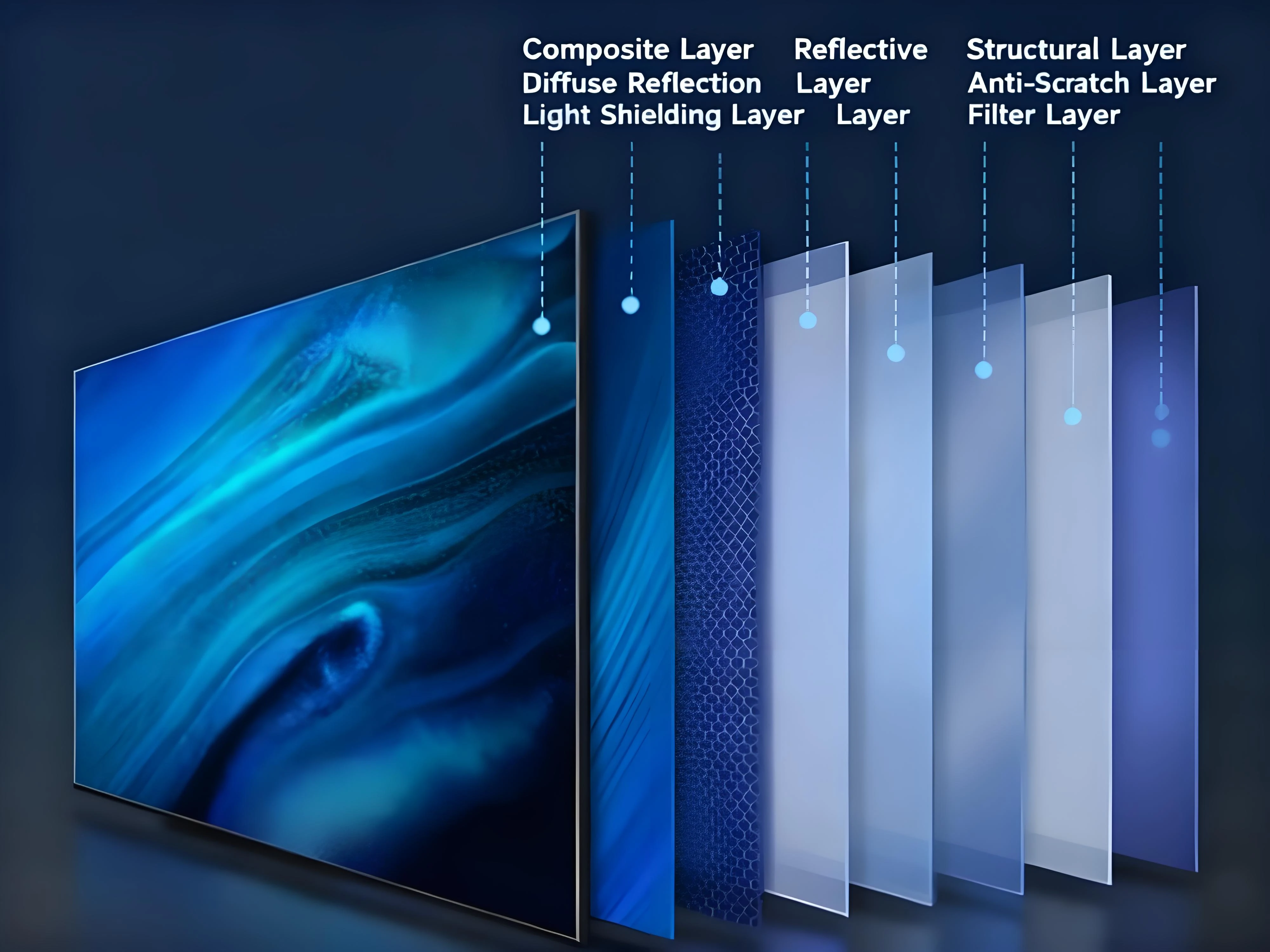
- Matte White/Fiberglass Screen: The most basic type of screen. Provides a gain of about 1.0, and it has a very wide viewing angle, making it more suitable for complete dark environmental conditions.
- High Contrast Gray Screen: Gain typically is less than 1.0. It produces deeper blacks and helps contrast by absorbing some ambient light. Typically used with projectors that have lower native contrast.
- Ambient Light Rejecting (ALR) Screen: Is an ALR screen worth it? If you regularly or usually watch in a brighter environment, then the answer is yes. This is the “black magic” that keeps the quality of the projection you are viewing.
- Ceiling Light Rejecting (CLR®) / Lenticular ALR: Budget friendly and specifically engineered to reject light coming down from the top, such as ceiling lights.
- Fresnel ALR: Performs fabulously, both for gain and light rejection, but has a more narrow viewing angle and higher cost. Also typically used with Ultra Short Throw (UST) projectors.
- Acoustically Transparent Screen: Designed to let sound come through the material. Allows for speakers to be placed behind the screen creating the immersive experience of “sound from the screen” experience.
Comparison of the Performance of Various Projection Surfaces
Feature/Surface | White Wall | Matte White | Gray Screen | ALR Screen (Lenticular/Fresnel) |
Contrast | ★☆☆☆☆ | ★★★☆☆ | ★★★★☆ | ★★★★★ |
Color Accuracy | ★★☆☆☆ | ★★★★★ | ★★★★☆ | ★★★★☆ |
Ambient Light Rejection | ★☆☆☆☆ | ★★☆☆☆ | ★★★☆☆ | ★★★★★ |
Flatness | ★☆☆☆☆ | ★★★☆☆ | ★★★☆☆ | ★★★★★ (Fixed Frame) |
Viewing Angle | ★★★★★ | ★★★★★ | ★★★★☆ | ★★★☆☆ |
Cost | Minimal | Low | Medium | High |
Best Environment | Emergency Use | Dedicated Dark Room | Room with faint light | Living Room / Bright Room |
Export to Sheets
How to Choose the Best Screen for Your DLP Projector
By following the steps below and considering your specific situation, your final decision can be made with confidence.
1. Ambient Light: The Primary Decision Factor
- Dedicated Home Theater (Completely Dark): A cost-effective Matte White or Fiberglass screen should be chosen. The most accurate colors and widest viewing angles will be delivered.
- Living Room (Some Ambient Light): An ALR screen is strongly recommended. This is the best way for a usable, and even excellent, image to be achieved during the day or with lights on.
2. Projector Specifications: Brightness and Throw Ratio
- Brightness (Lumens): An ALR screen may not be effective if paired with a low-brightness projector (<1000 ANSI Lumens). Conversely, a high-brightness projector combined with a high-gain screen may cause eye strain in a dark room. The right balance must be struck.
- Throw Ratio: Ultra Short Throw (UST) projectors require a specially designed Fresnel or lenticular ALR screen for the best results to be obtained.
3. Your Space and Budget
- Dedicated wall + desire for the best quality → A Fixed Frame screen is ideal.
- Living room + need for flexibility → A Motorized Retractable screen is more suitable (a tab-tensioned model is recommended).
- Budget can range from under a hundred dollars for an entry-level manual screen to several thousand for a high-end ALR screen.
4. Aspect Ratio
- 16:9: The mainstream choice, suitable for HDTV and streaming content.
- 2.35:1: The Cinemascope ratio, perfect for film enthusiasts.
- 4:3: An older format, now rarely used for home entertainment.
Limited Budget? DIY Screens and Proper Maintenance
The Feasibility of a DIY Screen
- Projector Screen Paint: If the wall is sanded to a smooth finish, it can be painted with special paint and achieve results better than standard latex paint.
- Build a Simple Frame: You can make a frame out of wood and stretch some bulk screen material over it for a very affordable option.
Care for Your Projector and Screen
- Projector: Make sure there is proper ventilation and the air filter is regularly maintained. Only use a lens cloth to clean the lens.
- Screen: Remove dust first with a soft brush. For a Matte White screen, use a soft cloth and the mildest neutral detergent. For ALR screens, since they have very fine surfaces, you will typically want to dry clean. Be sure to always refer to the manufacturer’s recommendations.
A Healthier Perspective: Why Are Projectors Considered Friendlier to the Eyes?
Projectors exhibit light being reflected off of a surface before it is seen by your eyes. The light being indirect, being slightly diffused is softer – being less irritating – and more natural like the light emitted by the sun while simultaneously sitting behind a screen. Additionally, studies suggest projectors emit much less blue light than a similarly sized LCD screen, making projectors more comfortable to watch.
Conclusion:
To return to the original question: Are screens necessary for your DLP projector?
Our answer follows: They are not required but they are recommended.
If you’re concerned about picture quality and want to see what you’re DLP projector is historically used for – high-contrast, large-screen – then a screen is best suited for your DLP projector. A screen reduces or eliminates the effects of ambient light, it restores true colors and enhances every detail in the image. You will be transformed from a watchable experience to an enjoyable experience.
You can project directly onto a white wall, but a professional screen is needed to unlock the projector's full image potential and get the best viewing experience.
A professional screen enhances overall brightness, contrast, and clarity by optimizing light reflection, ensuring color purity, and providing a perfectly smooth surface.
You should choose the best screen by considering your room's ambient light, the projector's brightness and throw ratio, and your available space and budget.
Yes, because projectors use reflected light, which is softer and emits less blue light, it causes less eye strain than the direct light from a TV.


